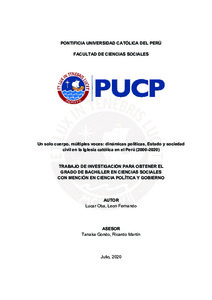Un solo cuerpo, múltiples voces: dinámicas políticas, Estado y sociedad civil en la Iglesia católica en el Perú (2000-2020)
Abstract
La presente investigación estudia las dinámicas políticas entre la jerarquía
eclesiástica y la sociedad civil eclesial “conservadora” y “progresista” en la Iglesia
católica en el Perú entre los años 2000 y 2020. El estudio se justifica debido a
que, si bien la Iglesia se configura como un actor social relevante, los pocos
estudios realizados se asemejan a narrativas fragmentadas que poco dialogan
entre sí. Así, pese a que el pluralismo al interior de la Iglesia siguió existiendo,
se pregunta por las razones que llevaron a un fortalecimiento del sector
“conservador” en detrimento del ala “progresista”. Las respuestas tentativas son
tres. La primera sostiene que pequeños grupos bien organizados cabildean para
que los obispos asuman determinadas agendas frente a otras. Una segunda
defiende la idea de que las directrices del Vaticano y de la jerarquía eclesiástica
local privilegian aquellas agendas afines a sus posturas. La tercera considera
que el apalancamiento social de movimientos y redes eclesiales impulsan a los
obispos a asumir las agendas del laicado militante. El trabajo se sustenta en la
teoría que ve a la Iglesia no como un actor monolítico, sino multivocal y
multifacético en el cual interactúan la jerarquía eclesiástica y la sociedad civil
eclesial –esfera independiente de la jerarquía y del Estado civil–. Para ello, la
metodología es de corte cualitativo y tiene como principal herramienta analítica
al process tracing. En definitiva, el estudio es una reconstrucción de narrativas
fragmentadas en torno a un actor social como la Iglesia que solo puede ser
entendido en términos de pluralismo intraeclesial y dinámicas políticas en
relación con la sociedad civil y el Estado. The aim of this project is to study the political dynamics between the
"conservative" and "progressive" ecclesiastical hierarchy and ecclesial civil
society in the Catholic Church in Peru between 2000 and 2020. The project is
justified because, although the Church is a relevant social actor, the few studies
carried out are similar to fragmented narratives that have little dialogue with each
other. Thus, despite the fact that pluralism within the Church continued to exist,
we wondered about the reasons that led to a strengthening of the "conservative"
sector to the detriment of the "progressive" wing. The tentative hypotheses are
three. The first holds that small, well-organized groups lobby for bishops to take
on certain agendas over others. A second one defends the idea that the directives
of the Vatican and the local ecclesiastical hierarchy privilege those agendas
related to their positions. The third considers that the social leverage of ecclesial
movements and networks impel the bishops to assume the agendas of the
militant laity. This project is based on the theory that sees the Church not as a
monolithic actor, but rather as a multivocal and multifaceted actor in which the
ecclesiastical hierarchy and ecclesial civil society –an independent sphere of
hierarchy and civil state– interact. In order to achieve this purpose, we use a
qualitative methodology and its main analytical tool is process tracing. In short,
the project is a reconstruction of fragmented narratives around the Church as a
social actor that can only be understood in terms of intra-ecclesial pluralism and
political dynamics in relation to civil society and the state.
Temas
Iglesia Católica--Perú
Iglesia y Estado--Perú
Religión y sociedad civil--Perú
Iglesia y Estado--Perú
Religión y sociedad civil--Perú
Para optar el título de
Bachiller en Ciencias Sociales con mención en Ciencia Política y Gobierno





